Exploring the Heartbeat of Bali: A Review of Balinese Dance, Drama & Music: A Guide to the Performing Arts of Bali
There are books that invite you into a world; then there are books that pull at your very soul, transporting you to another culture, another time. Balinese Dance, Drama & Music: A Guide to the Performing Arts of Bali by I Wayan Dibya and Rucina Ballinger is one of those rare treasures that managed to sweep me off my feet and into the vibrant heart of Bali’s performing arts. Having always been fascinated by the island’s unique culture, this book felt like a personal invitation to experience the intricate beauty of its traditional performances—a journey I couldn’t resist.
From the moment I opened its pages, I was captivated by the richness of content and the stunning visuals. The initial sections illuminate not only the various performing arts but also the cultural and religious significance behind each dance and musical form. The authors deftly explain that these performances are not mere entertainment; they are a crucial channel for storytelling, religious expression, and the preservation of Balinese identity. I found this deeply moving, as it reminds us that art often has a mission far greater than simply delighting the senses.
The book dives into a myriad of performances, from the mesmerizing Gamelan Gong Keybar to the intricate narratives of Wayang Kulit shadow puppets. Each chapter is filled with vivid illustrations and photographs that bring these performances to life, making you feel as if you’re right there, seated on the verdant grounds of a Balinese temple. Barbara Anello’s watercolor illustrations deserve a mention, as they add a dreamlike quality that complements the complexity of the performance art beautifully. I couldn’t help but dream of attending a Legong performance, feeling the vibrations of the gamelan orchestra resonate through my bones.
Dibya and Ballinger weave a narrative that’s as informative as it is poetic, emphasizing the significance of the arts in intergenerational teaching. The section on Women in Non-Traditional Roles stood out for me, challenging conventional norms and showcasing the evolving role of women in Balinese art—an empowering testament to change in a community known for its deep-rooted traditions. This aspect of the book not only educated me but sparked a broader reflection on the role of women in arts globally.
One line that resonated particularly with me was: “Every movement tells a story, every rhythm beats with the pulse of history.” It struck me as a universal truth, highlighting that no matter where we come from, the arts have a way of connecting our past to our present, allowing us to share our stories in profound ways.
In conclusion, Balinese Dance, Drama & Music is more than just a guide; it’s an immersion into an exquisite culture that celebrates life’s intricate tapestry through art. Whether you’re a traveler looking to enrich your experience in Bali or simply someone intrigued by world cultures, this book offers a delightful gateway. It not only deepened my appreciation for Balinese arts but also left me yearning for the sights and sounds of the island. I wholeheartedly recommend this book—it may just inspire you to hop on a plane and witness the magic for yourself.
You can find Balinese Dance, Drama & Music: A Guide to the Performing Arts of Bali here >>







